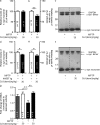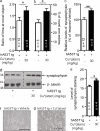The hypoxia imaging agent CuII(atsm) is neuroprotective and improves motor and cognitive functions in multiple animal models of Parkinson's disease
- PMID: 22473957
- PMCID: PMC3328361
- DOI: 10.1084/jem.20112285
The hypoxia imaging agent CuII(atsm) is neuroprotective and improves motor and cognitive functions in multiple animal models of Parkinson's disease
Abstract
Parkinson's disease (PD) is a progressive, chronic disease characterized by dyskinesia, rigidity, instability, and tremors. The disease is defined by the presence of Lewy bodies, which primarily consist of aggregated α-synuclein protein, and is accompanied by the loss of monoaminergic neurons. Current therapeutic strategies only give symptomatic relief of motor impairment and do not address the underlying neurodegeneration. Hence, we have identified Cu(II)(atsm) as a potential therapeutic for PD. Drug administration to four different animal models of PD resulted in improved motor and cognition function, rescued nigral cell loss, and improved dopamine metabolism. In vitro, this compound is able to inhibit the effects of peroxynitrite-driven toxicity, including the formation of nitrated α-synuclein oligomers. Our results show that Cu(II)(atsm) is effective in reversing parkinsonian defects in animal models and has the potential to be a successful treatment of PD.
Figures







Similar articles
-
Gene dysregulation is restored in the Parkinson's disease MPTP neurotoxic mice model upon treatment of the therapeutic drug Cu(II)(atsm).Sci Rep. 2016 Mar 1;6:22398. doi: 10.1038/srep22398. Sci Rep. 2016. PMID: 26928495 Free PMC article.
-
Resveratrol alleviates motor and cognitive deficits and neuropathology in the A53T α-synuclein mouse model of Parkinson's disease.Food Funct. 2018 Dec 13;9(12):6414-6426. doi: 10.1039/c8fo00964c. Food Funct. 2018. PMID: 30462117
-
Chronic intranasal deferoxamine ameliorates motor defects and pathology in the α-synuclein rAAV Parkinson's model.Exp Neurol. 2013 Sep;247:45-58. doi: 10.1016/j.expneurol.2013.03.017. Epub 2013 Mar 24. Exp Neurol. 2013. PMID: 23531432
-
Parkinson's disease and alpha synuclein: is Parkinson's disease a prion-like disorder?Mov Disord. 2013 Jan;28(1):31-40. doi: 10.1002/mds.25373. Mov Disord. 2013. PMID: 23390095 Review.
-
Therapeutic potentials of plant iridoids in Alzheimer's and Parkinson's diseases: A review.Eur J Med Chem. 2019 May 1;169:185-199. doi: 10.1016/j.ejmech.2019.03.009. Epub 2019 Mar 8. Eur J Med Chem. 2019. PMID: 30877973 Review.
Cited by
-
CuII (atsm) inhibits ferroptosis: Implications for treatment of neurodegenerative disease.Br J Pharmacol. 2020 Feb;177(3):656-667. doi: 10.1111/bph.14881. Epub 2020 Jan 14. Br J Pharmacol. 2020. PMID: 31655003 Free PMC article.
-
Empirical evidence for biometal dysregulation in Parkinson's disease from a systematic review and Bradford Hill analysis.NPJ Parkinsons Dis. 2022 Jun 27;8(1):83. doi: 10.1038/s41531-022-00345-4. NPJ Parkinsons Dis. 2022. PMID: 35760970 Free PMC article. Review.
-
Mitochondrial metals as a potential therapeutic target in neurodegeneration.Br J Pharmacol. 2014 Apr;171(8):2159-73. doi: 10.1111/bph.12513. Br J Pharmacol. 2014. PMID: 24206195 Free PMC article. Review.
-
Ligand and Linkage Isomers of Bis(ethylthiocarbamato) Copper Complexes with Cyclic C6H8 Backbone Substituents: Synthesis, Characterization, and Antiproliferation Activity.Eur J Inorg Chem. 2023 Dec 1;26(34):e202300447. doi: 10.1002/ejic.202300447. Epub 2023 Sep 14. Eur J Inorg Chem. 2023. PMID: 38584911 Free PMC article.
-
Homeostasis and metabolism of iron and other metal ions in neurodegenerative diseases.Signal Transduct Target Ther. 2025 Feb 3;10(1):31. doi: 10.1038/s41392-024-02071-0. Signal Transduct Target Ther. 2025. PMID: 39894843 Free PMC article. Review.
References
-
- Andreadou E., Nikolaou C., Gournaras F., Rentzos M., Boufidou F., Tsoutsou A., Zournas C., Zissimopoulos V., Vassilopoulos D. 2009. Serum uric acid levels in patients with Parkinson’s disease: their relationship to treatment and disease duration. Clin. Neurol. Neurosurg. 111:724–728 10.1016/j.clineuro.2009.06.012 - DOI - PubMed
Publication types
MeSH terms
Substances
LinkOut - more resources
Full Text Sources
Other Literature Sources
Medical
Molecular Biology Databases

